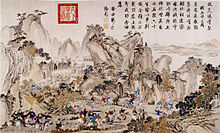This article needs additional citations for verification. (June 2013) |
| Sino-Nepalese War | |||||||
|---|---|---|---|---|---|---|---|
 | |||||||
| |||||||
| Belligerents | |||||||
|
| Gorkhalis | ||||||
| Commanders and leaders | |||||||
|
Qianlong Emperor Fuk'anggan 8th Dalai Lama |
Rana Bahadur Shah Bahadur Shah Damodar Pande Abhiman Singh Basnyat Kirtiman Singh Basnyat | ||||||
| Strength | |||||||
| 10,000[citation needed] | 5,000[citation needed] | ||||||
| Casualties and losses | |||||||
| Unknown | Unknown | ||||||
The Sino-Nepalese War (Nepali: नेपाल-चीन युद्ध), also known as the Sino-Gorkha War and in Chinese as the campaign of Gorkha (Chinese: 廓爾喀之役), was a war fought between the Qing dynasty of China and the Kingdom of Nepal in the late 18th century following an invasion of Tibet by the Nepalese Gorkhas. It was initially fought between Gorkhas and Tibetan armies in 1788 over a trade dispute related to a long-standing problem of low-quality coins manufactured by Nepal for Tibet. The Nepalese Army under Bahadur Shah plundered Tibet which was a Qing protectorate and Tibetans signed the Treaty of Kerung paying annual tribute to Nepal. However, Tibetans requested Chinese intervention and the Chinese imperial military forces under Fuk'anggan were sent to Tibet and repulsed the Gurkhas from the Tibetan plateau in 1792.[2] Sino-Tibetan forces marched into Nepal up to Nuwakot (near Nepal's capital Kathmandu) but faced a strong Nepalese counterattack. Thus, both countries signed the Treaty of Betrawati as a stalemate.[3][1] The war ended with Nepal accepting terms dictated by China. Nepal became a tribute state under Qing (Nepal maintains diplomacy and pays tribute). Nepal paid tribute to China in 1792, 1794, 1795, 1823, 1842 and 1865.[4] Both Nepal and Tibet also agreed to accept the suzerainty of the Qing emperor.
- ^ a b Regmi 1970a, p. 187.
- ^ Death and Dying in Northeast India. Taylor & Francis. 2023. ISBN 9780980045956. Retrieved August 24, 2023.
- ^ "Tibetan and Nepalese Conflict". Official website of Nepal Army.
- ^ Gundry, "Nepal," pp. 609-610., p. 609, at Google Books